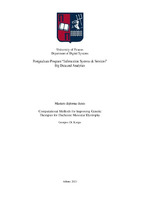| dc.contributor.advisor | Φιλιππάκης, Μιχαήλ | |
| dc.contributor.author | Κάργας, Γεώργιος | |
| dc.date.accessioned | 2021-04-21T07:14:30Z | |
| dc.date.available | 2021-04-21T07:14:30Z | |
| dc.date.issued | 2021 | |
| dc.identifier.uri | https://dione.lib.unipi.gr/xmlui/handle/unipi/13398 | |
| dc.identifier.uri | http://dx.doi.org/10.26267/unipi_dione/821 | |
| dc.format.extent | 50 | el |
| dc.language.iso | en | el |
| dc.publisher | Πανεπιστήμιο Πειραιώς | el |
| dc.rights | Αναφορά Δημιουργού - Μη Εμπορική Χρήση - Παρόμοια Διανομή 3.0 Ελλάδα | * |
| dc.rights.uri | http://creativecommons.org/licenses/by-nc-sa/3.0/gr/ | * |
| dc.title | Computational methods for improving genetic therapies for Duchenne Muscular Dystrophy | el |
| dc.type | Master Thesis | el |
| dc.contributor.department | Σχολή Τεχνολογιών Πληροφορικής και Επικοινωνιών. Τμήμα Ψηφιακών Συστημάτων | el |
| dc.description.abstractEN | Genetic engineering involves different techniques to intentionally modify genetic material (primarily deoxyribonucleic acid or DNA) in order to alter, restore, or boost shape or function. Established in the latter half of the twentieth century, recombinant DNA technologies include chemical splicing (recombination) of different strands of DNA, usually using either bacteria (such as Escherichia coli) or bacteriophages (viruses that infect bacteria, such as λ phage) or bacteria (viruses that infect bacteria, such as λ phage) or by way of simple microinjection. In recent years, modern techniques to design and create, literally to engineer, new life forms, typically referred to as synthetic biology, have supplemented these conventional instruments.
A flexible and efficient gene therapy technique is precision genome editing. The area has been subject to continuing developments since the introduction of CRISPR/Cas systems for genome editing. The new biotechnology includes the development of a site-specific DSB accompanied by two key forms of repair mechanisms: end-joining non-homologous and repair-directed homology. The enabled type of the mechanism for molecular repair relies on the cycle of the chromosome, cellular heterogeneity and cell division.
In the current diploma thesis, we tried to break down and understand the main components of prime editing technique. An automated approach is required for advancing our understanding of the evolution and diversity of prime editing and for finding new candidates for genome engineering. We used Duchenne Muscular Dystrophy as a use case for this proposed approach. More specifically, we applied the knowledge of machine learning over prime editing in the genetic disease of Duchenne Muscular Dystrophy. | el |
| dc.corporate.name | Εθνικό Κέντρο Έρευνας Φυσικών Επιστημών (Ε.Κ.Ε.Φ.Ε.) «Δημόκριτος» | el |
| dc.contributor.master | Προηγμένα Συστήματα Πληροφορικής | el |
| dc.subject.keyword | CRISPR | el |
| dc.subject.keyword | Gene therapies | el |
| dc.subject.keyword | Gene therapy | el |
| dc.subject.keyword | Duchenne Muscular Dystrophy | el |
| dc.subject.keyword | DMD | el |
| dc.subject.keyword | Computational biology | el |
| dc.subject.keyword | Computational genomics | el |
| dc.subject.keyword | Prime editing | el |
| dc.subject.keyword | Machine learning | el |
| dc.date.defense | 2021-02-20 | |



